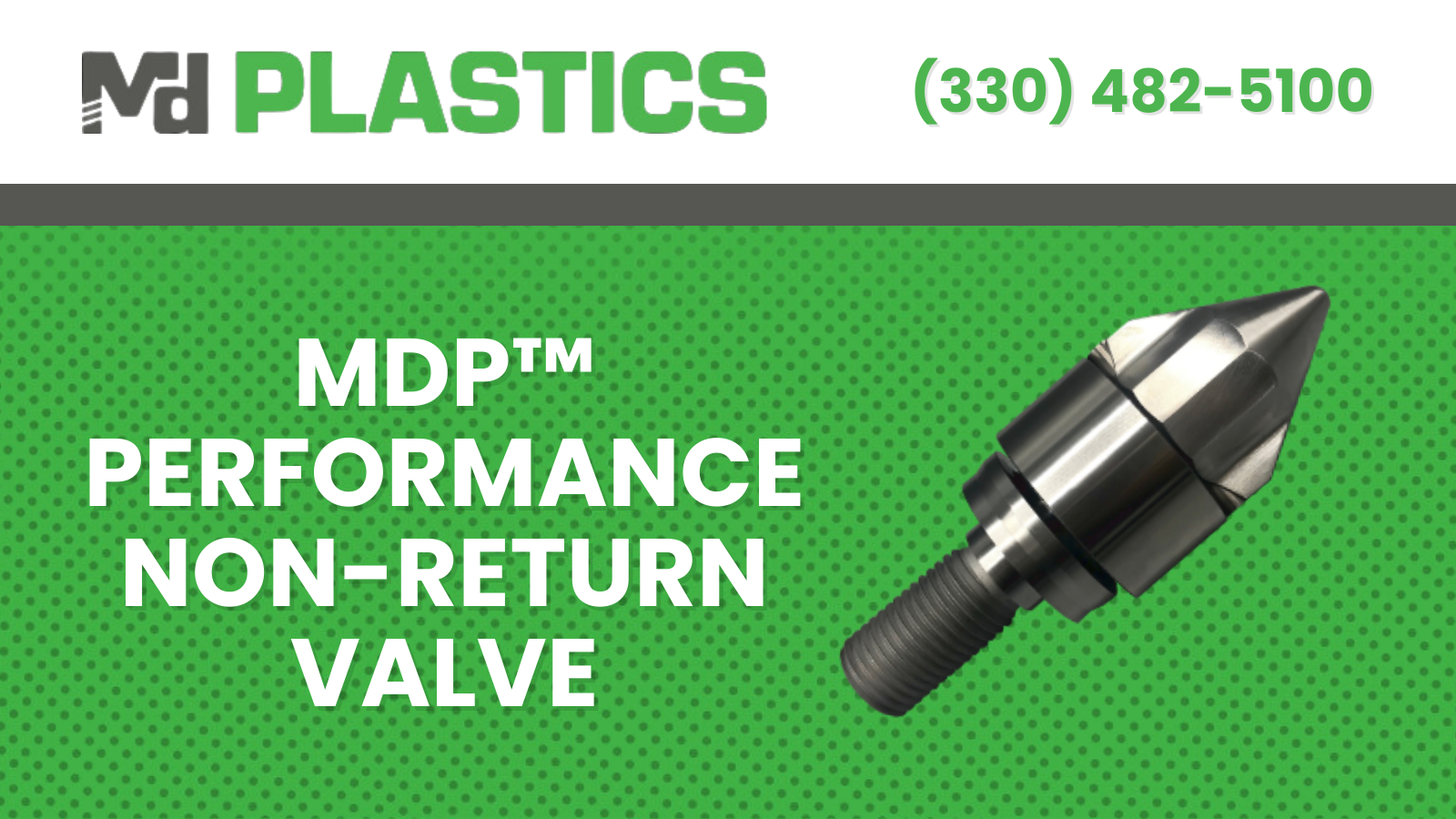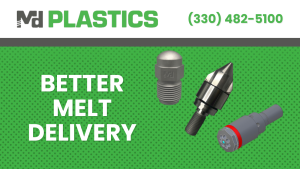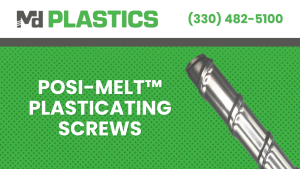When it comes to controlling the plastic melt during injection molding, two pieces of hardware often sit at the center of the debate: the non-return valve (NRV) and the shut-off valve nozzle. Both serve the critical purpose of controlling melt flow, maintaining part consistency, and reducing defects, but they go about it in very different ways. For processors, the decision of which to use isn’t always straightforward; it depends on resin type, molding environment, maintenance philosophy, and overall performance goals.
Understanding Hydraulic Theory and Flow Paths
At its most fundamental level, both NRVs and shut-off nozzles are about hydraulic control, managing the flow of molten polymer under pressure.
- Non-Return Valves (NRVs):
Positioned at the end of the screw, the NRV operates much like a one-way check valve. During screw recovery, the check ring slides back, allowing molten plastic to flow forward into the front of the barrel. When injection begins, pressure forces the check ring forward, closing the flow path and preventing melt from backflowing into the screw flights.
The flow path here is compact, directly integrated with the screw tip. Its simplicity is both an advantage (fewer moving parts) and a disadvantage (limited sealing reliability with abrasive or low-viscosity resins).
- Shut-Off Valve Nozzles:
Instead of relying on a sliding check ring, these nozzles feature an actively controlled mechanism (either mechanically actuated, spring-loaded, or hydraulically driven) that opens and closes the flow path between barrel and mold.
With this design, melt control occurs outside the screw, right at the nozzle interface. This relocation can reduce drool, stringing, and degradation, but it also adds complexity.
In terms of hydraulic theory, the NRV depends on differential pressure created during screw rotation versus injection, whereas the shut-off nozzle depends on mechanical actuation for flow regulation. Both methods achieve the same goal, stopping unwanted melt flow, but their flow paths affect pressure drop, shear, and ultimately melt quality.
ΔP (Pressure-Drop) Comparison
A central performance metric is ΔP, or pressure drop across the flow control device. Lower pressure drops mean:
- Less energy consumption by the injection unit
- Lower shear stress on the melt
- More consistent shot-to-shot quality
NRVs and Pressure Drop
Traditional NRVs often show significant ΔP due to turbulent flow paths created by the ring and seat geometry. As polymers pass around the check ring during recovery, high shear zones form. During injection, sealing surfaces can create restrictions that amplify ΔP, especially in filled or high-viscosity resins.
Shut-Off Nozzles and Pressure Drop
Shut-off nozzles can be engineered for smoother melt channels, but many standard designs still create bottlenecks. Spring-loaded shut-off pins, for instance, can obstruct flow, raising ΔP in high-speed applications.
Comparative Insight
Charting ΔP between the two shows that premium NRVs with optimized geometry (like Md Plastics’ MDP™ design) frequently outperform conventional shut-off nozzles. For example:
- Legacy NRVs: ΔP of 800–1200 psi depending on resin viscosity
- Standard Shut-Off Nozzles: ΔP of 600–1000 psi, varying by pin design
- MDP™ Valves: ΔP often <500 psi, with highly streamlined melt channels
This reduction not only improves energy efficiency but also maintains melt homogeneity, critical for tight-tolerance molding.
Wear Factors and Maintenance Concerns
Injection molders know that uptime equals profitability. The wrong choice of melt control can mean accelerated wear, unpredictable part weights, and frequent rebuilds.
NRV Wear Issues
- Check rings are prone to erosion from glass-filled materials
- Seat wear leads to leakage, causing shot-to-shot variation
- Galling can occur if lubrication is inconsistent
- Frequent inspections and replacements are required
Shut-Off Nozzle Wear Issues
- Moving pins can seize from material degradation or carbon buildup
- Springs weaken under heat cycling, leading to poor sealing
- Hydraulic-actuated systems require additional maintenance and monitoring
Maintenance Philosophy
- If you prioritize low maintenance and fewer moving parts, NRVs have an edge.
- If you prioritize precise on/off control at the nozzle, shut-off designs can help, but at the cost of increased service demands.
Decision Matrix by Resin Type
Not all resins behave alike. Choosing the correct melt control device often depends on polymer rheology, fillers, and processing window.
| Resin Type | Recommended Device | Rationale |
|---|---|---|
| Commodity resins (PE, PP, PS) | NRV | Low viscosity resins flow easily; optimized NRVs keep ΔP low and provide good seal reliability. |
| Engineering resins (ABS, PC, Nylon) | Either | Depends on part geometry. NRVs handle well, but shut-off nozzles may reduce stringing at mold parting line. |
| High-viscosity resins (PVC, POM) | Shut-Off Nozzle | Pin control minimizes drool and stringing with heat-sensitive materials. |
| Glass-filled resins | MDP™ NRV | Superior metallurgy resists wear, maintains ±0.5% part-weight variance. |
| Elastomers / TPEs | Shut-Off Nozzle | Reduces stringing issues that plague softer resins. |
This matrix isn’t absolute, but it underscores the importance of aligning melt-control hardware with resin behavior.
Why MDP™ Valves Redefine Melt Control
Since 1999, Md Plastics has focused on one thing: helping injection molders increase profitability by improving plasticating components. The MDP™ (Melt Directional Processing) valve is the culmination of decades of engineering and shop-floor testing.
Key Performance Stats
- Ultra-Low Pressure Drop: Streamlined geometry reduces ΔP, typically 30–50% lower than conventional NRVs or nozzles.
- Superior Shot-to-Shot Repeatability: Achieves ±0.5% part-weight variance, even in high-speed, high-cavitation molds.
- Material Flexibility: Optimized metallurgy and surface treatments resist abrasion and chemical attack.
- Extended Service Life: Reduced wear translates to longer maintenance intervals.
The Difference in Practice
Where traditional NRVs may drift out of tolerance after weeks of running glass-filled nylon, the MDP™ continues producing within spec for months. Where shut-off nozzles require hydraulic synchronization and extra downtime, the MDP™ maintains simplicity with performance.
In short, MDP™ valves combine the simplicity of NRVs with the performance benefits molders seek from shut-off systems, without the headaches.
Practical Considerations for Molders
Beyond technical specs, processors should evaluate melt control in terms of:
- Energy Efficiency: Lower ΔP means less back pressure required, reducing motor loads and energy bills.
- Consistency: Stable sealing translates to fewer rejects, less regrind, and leaner operations.
- Downtime Costs: Every minute of maintenance adds up; extended service life improves ROI.
- Resin Flexibility: The ability to switch materials without swapping hardware adds versatility.
For many molders, these factors matter more than the initial device cost.
Final Thoughts: Non-Return Valves vs. Shut-Off Nozzles
So, which controls melt better? The answer depends on your priorities:
- If you need precise on/off control at the nozzle tip (especially for heat-sensitive or stringy resins), a shut-off nozzle has advantages.
- If you want low ΔP, fewer maintenance headaches, and exceptional shot-to-shot consistency, an advanced NRV, particularly the MDP™, is the smarter long-term choice.
In the end, it’s not just about stopping melt. It’s about controlling profitability, part quality, and operational efficiency.
Take the Next Step
At Md Plastics, we’ve been solving melt-control challenges for injection molders since 1999. Our team designs and manufactures superior plasticating components and breakthrough technologies that make a measurable difference on the production floor. Whether you’re battling drool, struggling with shot-to-shot inconsistency, or looking to improve energy efficiency, we have the expertise and products to deliver.
Explore the MDP™ valve and our full line of melt-control solutions. Let’s work together to take your molding process to the next level.




